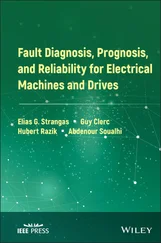1 COVER
2 TITLE PAGE
3 COPYRIGHT PAGE
4 DEDICATION PAGE
5 ABOUT THE EDITOR
6 ABOUT THE CONTRIBUTORS
7 CHAPTER 1: GENERAL CONSIDERATIONS 1.1 PRELUDE 1.2 DEFINING SSE 1.3 THE NEED FOR STATE ESTIMATION 1.4 STATIC STATE ESTIMATION IN PRACTICE 1.5 APPLICATIONS THAT USE SE SOLUTION 1.6 OVERVIEW OF CHAPTERS REFERENCES
8 CHAPTER 2: STATE ESTIMATION IN POWER SYSTEMS BASED ON A MATHEMATICAL PROGRAMMING APPROACH 2.1 INTRODUCTION 2.2 FORMULATION 2.3 CLASSICAL STATE ESTIMATION PROCEDURE 2.4 MATHEMATICAL PROGRAMMING SOLUTION 2.5 ALTERNATIVE STATE ESTIMATORS REFERENCES
9 PART I: SYSTEM FAILURE MITIGATION CHAPTER 3: SYSTEM STRESS AND CASCADING BLACKOUTS 3.1 INTRODUCTION 3.2 CASCADING BLACKOUTS AND PREVIOUS WORK 3.3 PROBLEM STATEMENT AND APPROACH 3.4 DFAXes, VULNERABILITY, AND CRITICALITY METRICS 3.5 VALIDITY OF METRICS 3.6 STUDIES WITH METRICS 3.7 SUMMARY 3.8 APPLICATION OF STRESS METRICS 3.9 CONCLUSIONS ACKNOWLEDGMENTS REFERENCES CHAPTER 4: MODEL‐BASED ANOMALY DETECTION FOR POWER SYSTEM STATE ESTIMATION 4.1 INTRODUCTION 4.2 CYBERATTACKS ON STATE ESTIMATION 4.3 ATTACK‐RESILIENT STATE ESTIMATION 4.4 MODEL‐BASED ANOMALY DETECTION 4.5 CONCLUSIONS REFERENCES CHAPTER 5: PROTECTION, CONTROL, AND OPERATION OF MICROGRIDS 5.1 PRELUDE 5.2 INTRODUCTION 5.3 STATE OF THE ART IN MICROGRID PROTECTION AND CONTROL 5.4 EMERGING TECHNOLOGIES 5.5 TEST CASE FOR DDSE 5.6 TEST RESULTS 5.7 TEST CASE FOR ADAPTIVE SETTING‐LESS PROTECTION 5.8 CONCLUSIONS REFERENCES
10 PART II: ROBUST STATE ESTIMATION CHAPTER 6: PSSE REDUX: CONVEX RELAXATION, DECENTRALIZED, ROBUST, AND DYNAMIC SOLVERS 6.1 INTRODUCTION 6.2 POWER GRID MODELING 6.3 PROBLEM STATEMENT 6.4 DISTRIBUTED SOLVERS 6.5 ROBUST ESTIMATORS AND CYBERATTACKS 6.6 POWER SYSTEM STATE TRACKING 6.7 DISCUSSION ACKNOWLEDGMENTS 6.A APPENDIX REFERENCES CHAPTER 7: ROBUST WIDE‐AREA FAULT VISIBILITY AND STRUCTURAL OBSERVABILITY IN POWER SYSTEMS WITH SYNCHRONIZED MEASUREMENT UNITS 7.1 INTRODUCTION 7.2 ROBUST FAULT VISIBILITY USING STRATEGICALLY DEPLOYED SYNCHRONIZED MEASUREMENTS 7.3 OPTIMAL PMU DEPLOYMENT FOR SYSTEM‐WIDE STRUCTURAL OBSERVABILITY 7.4 CONCLUSIONS ACKNOWLEDGMENTS REFERENCES CHAPTER 8: A ROBUST HYBRID POWER SYSTEM STATE ESTIMATOR WITH UNKNOWN MEASUREMENT NOISE 8.1 INTRODUCTION 8.2 PROBLEM STATEMENT 8.3 PROPOSED FRAMEWORK FOR ROBUST HYBRID STATE ESTIMATION 8.4 NUMERICAL RESULTS 8.5 CONCLUSIONS REFERENCES CHAPTER 9: LEAST‐TRIMMED‐ABSOLUTE‐VALUE STATE ESTIMATOR 9.1 BAD DATA DETECTION AND ROBUST ESTIMATORS 9.2 RESULTS AND DISCUSSION 9.3 CONCLUSIONS 9.A.1 6‐Bus DC System 9.A.2 6‐Bus AC System 9.B 14‐Bus AC System 9.C 30‐Bus AC System REFERENCES
11 PART III: STATE ESTIMATION FOR DISTRIBUTION SYSTEMS CHAPTER 10: PROBABILISTIC STATE ESTIMATION IN DISTRIBUTION NETWORKS 10.1 INTRODUCTION 10.2 STATE ESTIMATION IN DISTRIBUTION NETWORKS 10.3 IMPROVING OBSERVABILITY IN DISTRIBUTION NETWORKS 10.4 CONCLUSION REFERENCES CHAPTER 11: ADVANCED DISTRIBUTION SYSTEM STATE ESTIMATION IN MULTI‐AREA ARCHITECTURES 11.1 ISSUES AND CHALLENGES OF DISTRIBUTION SYSTEM STATE ESTIMATION 11.2 DISTRIBUTION SYSTEM MULTI‐AREA STATE ESTIMATION (DS‐MASE) APPROACH 11.3 APPLICATION OF THE DS‐MASE APPROACH 11.4 VALIDITY AND APPLICABILITY OF DS‐MASE APPROACH REFERENCES
12 PART IV: PARALLEL/DISTRIBUTED PROCESSING CHAPTER 12: HIERARCHICAL MULTI‐AREA STATE ESTIMATION 12.1 INTRODUCTION 12.2 PRELIMINARIES 12.3 MODELING AND PROBLEM FORMULATION 12.4 A BRIEF SURVEY OF SOLUTION TECHNIQUES 12.5 HIERARCHICAL STATE ESTIMATOR VIA SENSITIVITY FUNCTION EXCHANGES 12.6 ADD‐ON FUNCTIONS IN MULTI‐AREA STATE ESTIMATION 12.7 PROPERTIES 12.8 SIMULATIONS 12.9 CONCLUSIONS ACKNOWLEDGMENTS REFERENCES CHAPTER 13: PARALLEL DOMAIN‐DECOMPOSITION‐BASED DISTRIBUTED STATE ESTIMATION FOR LARGE‐SCALE POWER SYSTEMS 13.1 INTRODUCTION 13.2 FUNDAMENTAL THEORY AND FORMULATION 13.3 EXPERIMENTAL RESULTS 13.4 CONCLUSION REFERENCES CHAPTER 14: DISHONEST GAUSS–NEWTON METHOD‐BASED POWER SYSTEM STATE ESTIMATION ON A GPU 14.1 INTRODUCTION 14.2 BACKGROUND 14.3 PERFORMANCE OF DISHONEST GAUSS–NEWTON METHOD 14.4 GPU IMPLEMENTATION 14.5 SIMULATION RESULTS 14.6 DISCUSSIONS ON SCALABILITY 14.7 DISTRIBUTED METHOD OF PARALLELIZATION 14.8 CONCLUSIONS REFERENCES
13 INDEX
14 IEEE PRESS SERIES ON POWER ENGINEERING
15 END USER LICENSE AGREEMENT
1 Chapter 2 TABLE 2.1 Line parameters. TABLE 2.2 Voltages: measured, true and estimated values. TABLE 2.3 Power injections: measured, true and estimated values. TABLE 2.4 Power flows: measured, true and estimated values. TABLE 2.5 State‐variable updates and convergency summary. TABLE 2.6 Residuals and normalized residuals. TABLE 2.7 Characterization of different state‐estimation formulations. TABLE 2.8 Example of alternative estimators: line characteristics. TABLE 2.9 Example of alternative estimators: operating point. TABLE 2.10 Example of alternative estimators: measurements. TABLE 2.11 Example of alternative estimators: characterization. TABLE 2.12 Example of alternative estimators: optimal values for the binary varia... TABLE 2.13 Example of alternative estimators: true and estimated state vectors. TABLE 2.14 Case study: estimation accuracy results. TABLE 2.15 Case study: computational performance results. TABLE 2.16 Case study: estimation accuracy results with bad measurements. TABLE 2.17 Case study: computational performance results with bad measurements.
2 Chapter 3TABLE 3.1 Ybus structure for the nine‐branch subsystem.TABLE 3.2 DFAX matrix and pre‐contingency flows for nine‐branch subsystem....TABLE 3.3 N − 1 flows, rank and degree of vulnerability and criticality, for nine...TABLE 3.4 Number of large DFAX compared with number of monitored branches.TABLE 3.5 Load growth and system expansion, congestion, and stress [19].
3 Chapter 4TABLE 4.1 Synthesis of related work.TABLE 4.2 Experimental parameters for case study.TABLE 4.3 Power flow solution for the example.TABLE 4.4 SE outputs and predicted states for the example.TABLE 4.5 Comparison of differences with detection thresholds.
4 Chapter 5TABLE 5.1 Example branch data for the topology in Figure 5.1 (A > B means B is th...TABLE 5.2 Example coordination data for the topology in Figure 5.1.TABLE 5.3 Parameters for line impedances per unit length.TABLE 5.4 Line length of distribution lines.TABLE 5.5 Power injection by loads.TABLE 5.6 Standard deviation of measurements.TABLE 5.7 Parameters for the wind turbine generator.TABLE 5.8 Test scenarios.
5 Chapter 6TABLE 6.1 Mean‐square estimation error in the presence of bad data.
6 Chapter 7TABLE 7.1 Synchronized sensor locations versus wave arrival times for the fault o...TABLE 7.2 Values of ℓ, , ψ(ℓ) (in ms), (in ms), and Dℓ (in ms) for the fault occ...TABLE 7.3 Synchronized sensor locations versus wave arrival times (after correcti...TABLE 7.4 Optimal PMU deployment results for three IEEE test systems.
7 Chapter 9TABLE 9.1 Simulated measurements for 6‐bus DC system.TABLE 9.2 Estimation results of case 0, 6‐bus DC system.TABLE 9.3 Estimation errors of case 0, 6‐bus DC system.TABLE 9.4 Estimation results of case 1, 6‐bus DC system.TABLE 9.5 Estimation errors of case 1, 6‐bus DC system.TABLE 9.6 Estimation results of case 2, 6‐bus DC system.TABLE 9.7 Estimation errors of case 2, 6‐bus DC system.TABLE 9.8 Estimation results of case 3, 6‐bus DC system.TABLE 9.9 Estimation errors of case 3, 6‐bus DC system.TABLE 9.10 Comparison of 6‐bus indicators.TABLE 9.11 Simulated measurements for 6‐bus AC system.TABLE 9.12 Estimation errors of case 0, 6‐bus AC system.TABLE 9.13 Estimation errors of case 1, 6‐bus AC system.TABLE 9.14 Estimation errors of case 2, 6‐bus AC system.TABLE 9.15 Estimation errors of case 3, 6‐bus AC system.TABLE 9.16 Comparison of indicators for 6‐bus AC system.TABLE 9.17 Actual values for 14‐bus AC system.TABLE 9.18 Measured meters for 14‐bus AC system, full redundancy.TABLE 9.19 Selected measured meters for 14‐bus AC system, median redundancy....TABLE 9.20 Full redundancy of 14‐bus AC system.TABLE 9.21 Median redundancy of 14‐bus AC system.TABLE 9.22 Actual and measured values for 30‐bus AC system.TABLE 9.23 Median redundancy of 30‐bus AC system. TABLE 9.A.1 Line data of 6‐bus DC system.TABLE 9.A.2 Bus data of 6‐bus DC system. TABLE 9.A.3 Line data of 6‐bus AC system.TABLE 9.A.4 Bus data of 6‐bus AC system. TABLE 9.B.1 Line data of 14‐bus AC system.TABLE 9.B.2 Bus data of 14‐bus AC system. TABLE 9.C.1 Line data of 30‐bus AC system.TABLE 9.C.2 Bus data of 30‐bus AC system.
Читать дальше












